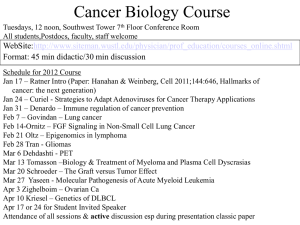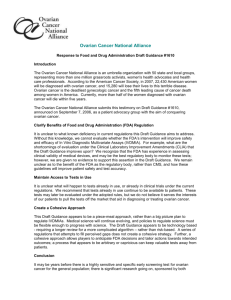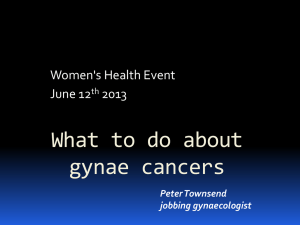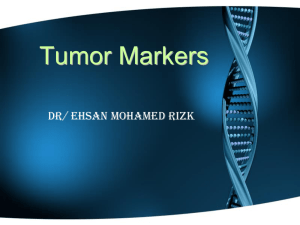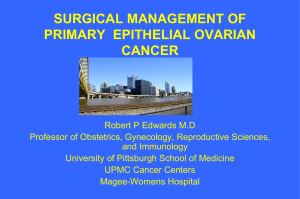New technologies for the early detection of cancer are now at hand
advertisement
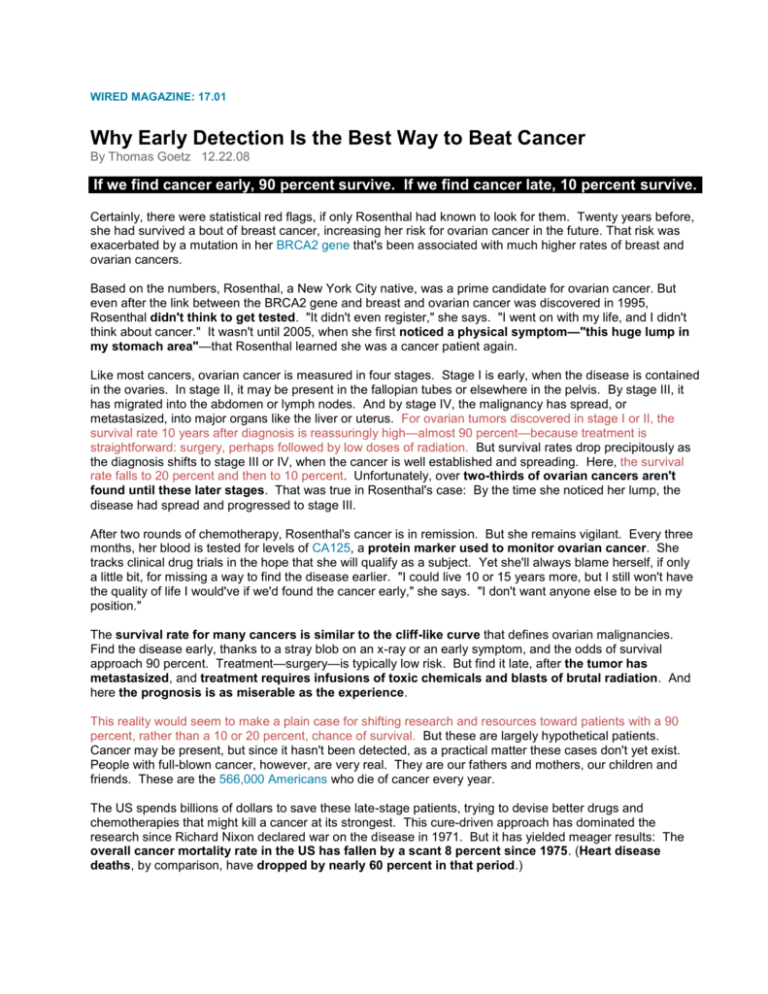
WIRED MAGAZINE: 17.01 Why Early Detection Is the Best Way to Beat Cancer By Thomas Goetz 12.22.08 If we find cancer early, 90 percent survive. If we find cancer late, 10 percent survive. Certainly, there were statistical red flags, if only Rosenthal had known to look for them. Twenty years before, she had survived a bout of breast cancer, increasing her risk for ovarian cancer in the future. That risk was exacerbated by a mutation in her BRCA2 gene that's been associated with much higher rates of breast and ovarian cancers. Based on the numbers, Rosenthal, a New York City native, was a prime candidate for ovarian cancer. But even after the link between the BRCA2 gene and breast and ovarian cancer was discovered in 1995, Rosenthal didn't think to get tested. "It didn't even register," she says. "I went on with my life, and I didn't think about cancer." It wasn't until 2005, when she first noticed a physical symptom—"this huge lump in my stomach area"—that Rosenthal learned she was a cancer patient again. Like most cancers, ovarian cancer is measured in four stages. Stage I is early, when the disease is contained in the ovaries. In stage II, it may be present in the fallopian tubes or elsewhere in the pelvis. By stage III, it has migrated into the abdomen or lymph nodes. And by stage IV, the malignancy has spread, or metastasized, into major organs like the liver or uterus. For ovarian tumors discovered in stage I or II, the survival rate 10 years after diagnosis is reassuringly high—almost 90 percent—because treatment is straightforward: surgery, perhaps followed by low doses of radiation. But survival rates drop precipitously as the diagnosis shifts to stage III or IV, when the cancer is well established and spreading. Here, the survival rate falls to 20 percent and then to 10 percent. Unfortunately, over two-thirds of ovarian cancers aren't found until these later stages. That was true in Rosenthal's case: By the time she noticed her lump, the disease had spread and progressed to stage III. After two rounds of chemotherapy, Rosenthal's cancer is in remission. But she remains vigilant. Every three months, her blood is tested for levels of CA125, a protein marker used to monitor ovarian cancer. She tracks clinical drug trials in the hope that she will qualify as a subject. Yet she'll always blame herself, if only a little bit, for missing a way to find the disease earlier. "I could live 10 or 15 years more, but I still won't have the quality of life I would've if we'd found the cancer early," she says. "I don't want anyone else to be in my position." The survival rate for many cancers is similar to the cliff-like curve that defines ovarian malignancies. Find the disease early, thanks to a stray blob on an x-ray or an early symptom, and the odds of survival approach 90 percent. Treatment—surgery—is typically low risk. But find it late, after the tumor has metastasized, and treatment requires infusions of toxic chemicals and blasts of brutal radiation. And here the prognosis is as miserable as the experience. This reality would seem to make a plain case for shifting research and resources toward patients with a 90 percent, rather than a 10 or 20 percent, chance of survival. But these are largely hypothetical patients. Cancer may be present, but since it hasn't been detected, as a practical matter these cases don't yet exist. People with full-blown cancer, however, are very real. They are our fathers and mothers, our children and friends. These are the 566,000 Americans who die of cancer every year. The US spends billions of dollars to save these late-stage patients, trying to devise better drugs and chemotherapies that might kill a cancer at its strongest. This cure-driven approach has dominated the research since Richard Nixon declared war on the disease in 1971. But it has yielded meager results: The overall cancer mortality rate in the US has fallen by a scant 8 percent since 1975. (Heart disease deaths, by comparison, have dropped by nearly 60 percent in that period.) We are so consumed by the quest to save the 566,000 that we overlook the far more staggering statistic at the other side of the survival curve: More than a third of all Americans—some 120 million people—will be diagnosed with cancer sometime in their lives. Their illness may be invisible now, but it's out there. And that presents a great, and largely unexamined, opportunity: Find and treat their cancers early and that 566,000 figure will shrink. The National Cancer Institute spends just 8 percent of its research funds on early detection. Cancer has a perception problem. We lack the ability to see what's going on inside the body, to gaze through our too-solid flesh and glean information on a molecular level. Conventional medical technologies—blood tests, x-rays, MRIs—can serve as proxies for proximity, but the picture they offer is often incomplete and obscured. Without a way to positively identify illness early, to detect that first spark, medicine will continue to be a last resort. New technologies for the early detection of cancer are now at hand. Researchers are refining sophisticated protein tests that can pick up molecular whispers in the bloodstream and are testing next-generation imaging techniques that can identify and isolate a tumor within the body. These technologies build on screening methods already proven to reveal cancer—the Pap smear (cervical), the antibody blood test (prostate), the mammogram (breast)—but go further and deeper so that even stubbornly covert cancers might become visible. This new approach treats diagnosis as an algorithm, a sequence of calculations that can detect or predict cancer years before it betrays symptoms. It starts with a statistical screening to identify people, like Rosenthal, who have a genetically greater risk for disease. A regular blood test follows, one primed to look for telltale proteins or biomarkers, correlated to specific cancers. A positive result prompts an imaging test to eliminate false positives or isolate a tumor. The process is methodical, mathematical, and much more likely to find cancer than current diagnostic procedures. This is the potential of early detection: To use data instead of drugs, to reveal a cancer before it reveals itself, and to leave the miracles for the patients who really need them. Don Listwin learned about the 90/10 survival curve after his mother, Grace, was diagnosed with ovarian cancer in 2000. Doctors had diagnosed her—twice—with a bladder infection and prescribed antibiotics. Not surprisingly, that treatment didn't work. By the time her doctor established that she had ovarian cancer, she was stage IV and 12 months from her death. Listwin, a onetime heir apparent to CEO John Chambers at Cisco Systems, says his impulse was to sue the doctor, the hospital, and anyone else who looked culpable. "I thought their incompetence had killed my mother," he says now. "But then I started staring at this 90 percent and this 10 percent, and I realized that if she had just been over here at 90, she'd be alive today." An electrical engineer by training, Listwin started to ask questions. Why does survival drop off so steeply? What happens in later stage cancers that make them so lethal? And most obviously, why can't we find the killer cancers early? "This looked like an emergent systems engineering problem, a systems biology problem," he says. "And it looked like an opportunity to engineer solutions." Listwin, who says he was at Cisco during "the right 10 years," left the company in 2000 at age 41 with $100 million in the bank. Typically, people like Listwin—wealthy, philanthropic, and touched by cancer's ruthlessness—get on the cure bandwagon. But after looking at the numbers, Listwin was drawn to the problem of early detection. In 2004, he created the Canary Foundation, a research group with the single goal of bringing a battery of screening tests to patients and their doctors by 2015, starting with ovarian cancer and moving on to pancreatic, lung, and prostate. Listwin likes to explain the Canary approach with PowerPoint, and every presentation starts with a slide of the survival curve for cancer. Pointing to the 90 percent, he makes this simple observation: When we see cancer early, we have a chance to fight it. In fact, much of the meager increase in cancer survival rates over the past 30 years can be attributed not to new chemotherapies or treatments but to early detection. Deaths from skin cancer, which is the most obvious to diagnose and treat, have fallen 10 percent. Since the Pap smear—a simple swab of the cervix for precancerous and cancerous cells—became part of routine care in the US in the 1950s, cancer incidence and mortality rates due to cervical cancer have fallen by 67 percent. Five-year survival rates for breast cancer have likewise improved as mammography and MRI screening have increased. There are tests for these diseases not because they are biologically different from other cancers but because they occur in accessible parts of the body. It's neither difficult nor prohibitively expensive nor dangerous to swab a cervix or perform a mammogram. Other areas of the body, though—the lungs, the pancreas—are less accessible and harder to monitor. Consequently, their malignancies are far more deadly. Despite this proven model, early detection is an afterthought in cancer research. The pharmaceutical industry spends nearly $8 billion annually on cancer research, according to the International Union Against Cancer, most of it steered toward drug development and late-stage treatments. The major cancer foundations spend lavishly on cure-based research: The Susan G. Komen Breast Cancer Foundation spent $180 million on cures in 2007; the Michael Millken Prostate Cancer Foundation spends about $14 million annually pursuing a cure for prostate cancer; the National Cancer Institute spent just 8 percent of its 2007 budget, less than $400 million, on detection and diagnosis research. Compared to these sums, Canary's $5 million annual budget scarcely registers. Yet Canary stands out in the cancer research community because its focus on early detection rather than treatment. The Riddle of Early Detection More than 140 million Americans will get cancer at some point in their lives. Find the disease early and survival rates are high. Catch it late and it's much more likely to be fatal. There are three main hurdles to clear before widespread early detection becomes possible. Some cancers can be too easy to find. About 80 percent of prostate cancers are detected early. Yet most patients survive at least five years even if untreated. The problem: deciding whether medical intervention is necessary. Other cancers are inherently The money goes where the elusive. cancer is. Pancreatic cancer, for one, Some malignancies, notably lung betrays almost no symptoms, cancer, are mostly detected only in making diagnosis a matter of late stages. As a result, that's where pure luck. Only 3 percent of most research is directed. Shifting cases are found in the first, most those priorities won't be easy. curable stage. A creature of Silicon Valley, Listwin based his foundation in San Jose and has structured it like a tech startup. Canary has recruited some of the nation's foremost oncologists, molecular scientists, and biostatisticians— researchers from the Fred Hutchinson Cancer Research Center in Seattle, New York's Memorial SloanKettering Cancer Center, and Stanford School of Medicine—and assigned them to one of four teams, each of which concentrates on a specific cancer. The foundation uses its grants as seed capital. Research is closely tracked so that years aren't lost in the lab. Failure is allowed, so long as it happens fast. And in contrast to many big-ticket medical technologies, there's a priority on making costs for a test low enough that innovations can be widely deployed. The objective is to draw in research money from the NCI and other cancer foundations as well as venture capital, jump-starting an industry. Once that happens, Listwin's exit strategy will be easy: "I'll be on the beach in Belize," he says. In case the allusion isn't obvious, the Canary Foundation takes its name from the avian early detection system used by coal miners. Listwin, whose year-round tan, golf-pro good looks, and cheerful swagger make him seem younger than his 49 years, adopts the plumage of the namesake bird at every opportunity, wearing a canary yellow blazer at most foundation functions. (At outside meetings, he goes with a buttercup oxford shirt, tucking a matching pocket square in a blue coat.) Given his manner, though, the yellow jacket brings to mind less a songbird than a hornet, buzzing around and ever-ready to engage. Last May, at the foundation's annual science meeting at Stanford, Listwin was in typically high spirits. The Canary Symposium pulls together the 125 scientists who work on Canary research in the US and Canada. For them, the symposium is an opportunity to share progress, swap strategies, and meet such luminaries as NCI director John Niederhuber and Nobel laureate Lee Hartwell, director of the Hutchinson Center and chair of Canary's science team. It's also a chance to get a taste of Silicon Valley swank. Listwin makes a point of serving the best food and drink during the three-day event; a friend who is an avid wine collector generously uncorks several cases of remarkable wines, from 30-year-old Bordeaux to $300 California zinfandels. It makes for a blithe mood, and this year, Listwin had extra reason to be jazzed. He'd just announced an agreement with Stanford to build a new research center focused on early detection. Scheduled to open this year, the Canary Center at Stanford will be a headquarters for Sam Gambhir, director of the university's molecular-imaging program and the developer of a promising new ultrasound technology that's central to Canary's efforts. Listwin is much more engaged than the average philanthropist. Rather than dole out research money and send the scientists back to their labs, he's involved in each step of the scientific process, from generating hypotheses to analyzing the data. Ever the engineer, he has schooled himself in the minutiae of biomarkers and cancer genetics and readily interrupts a presentation to correct a scientific point. (At a recent meeting of the NCI's Early Detection Research Network, he was mistakenly introduced as "Dr. Don Listwin.") And drawing from his corporate days, Listwin applies classic group management theories to the effort. "It's basic team-building," he says. "Forming, storming, norming, and performing." Each member of the team is responsible for a different link in the chain leading to a workable screening test— or more accurately, toward two tests: a biomarker blood test to identify a cancer, followed by an imaging test to isolate it in the body. Some group members are engaged in proteomics—running tissue samples through mass spectrometers to uncover the proteins that may be biomarkers for a particular type of cancer and then handing off promising proteins to other specialists who use statistical methods to confirm the correlation. Others are developing new imaging tools that can pinpoint a tumor as small as 2 millimeters across. Still others design cost-benefit models to determine whether a test has commercial potential. And in contrast to the five-year duration of a standard NCI grant, Canary reviews its grants annually. "Most scientists aren't used to doing things this way," says Martin McIntosh, a bioinformatics guru at the Hutchinson Center and member of Canary's ovarian team. "If something's not working, Don's not afraid to pull the plug. So that takes some getting used to. But there's definitely a sense that we're getting somewhere, that we're working on this problem in a new and smart way." The Canary approach comes at a time when the NCI is in the midst of what director Niederhuber calls "a big pivot" away from a single-minded war approach and toward a portfolio of strategies, including prevention and early detection. But 40 years into the war on cancer, he says, changing the course of the NCI is akin to turning around the proverbial aircraft carrier. That leaves the "well-informed higher-risk activities" to more agile groups like Canary. "New screening approaches are increasingly important. I think eventually you'll go in for a pit stop on a regular basis," Niederhuber says. "And with a little bit of blood, we'll know what's normal and what's abnormal." The typical human body contains less than 2 gallons of blood. The bloodstream is a transport system, a combination of plasma—the fluid itself—mostly red and white blood cells, which distribute oxygen and fight infection. Blood also contains thousands of proteins that serve a range of biological purposes, from distributing energy and nutrition to repairing injury and inflammation. The science of proteomics is trying to correlate each of these proteins with its specific metabolic function. When the first Canary team came together in 2004, proteomics promised to be a powerful tool for early detection. All the teams needed to do was pump biomarkers through the testing process, identify a handful that link to early-stage cancers, corroborate the results with a CT scan or MRI, and then roll out the early-detection test. "It looked like a pretty simple problem," says Patrick Brown, a molecular biologist at Stanford and member of Canary's ovarian cancer team. "Get a molecule, make a test, and you're done. It was just a matter of going out and finding them." Brown doesn't think that anymore. "It's gone from something that seems really simple and really boring scientifically," he says, "to something that's not at all simple and, therefore, really compelling scientifically." He functions at Canary as something of a bug tester, probing for logical flaws, false assumptions, and wishful thinking. The complications that have turned up around blood protein biomarkers, he says, are riddles that must be solved before the way forward becomes clear. And two riddles stand out. The first goes something like this: In the past decade, proteomics has been great at discovery—the eureka moment when a protein is identified and strongly associated with a cancer. The field has identified thousands of proteins in cancerous human tissue, and hundreds of research papers have claimed strong correlations between a particular new marker and a certain type of cancer. But there's been a dearth of validation—the more laborious process of confirming the results and establishing that a protein actually does work as a biomarker for a particular cancer and isn't the result of some unrelated condition like inflammation or anxiety. The problem starts with the very structure of the proteomic investigations. Most of these are case/control studies, in which proteins extracted from known cancer patients (the cases) are compared with proteins extracted from healthy volunteers (the controls). In a perfect study, you want the cases and the controls to match up in every way—age, sex, diet, home town—except for the fact that half of the sample has cancer. That way, any differences that turn up are statistically likely to be due to the cancer. But in reality, good samples of cancer tissue are in short supply, so most research is done in a take-what-you-can-get mode. The controls are assembled afterward and matched as well as possible. The result is that the cases and controls often have little in common—they can come from people of different ages, different towns, or countless other variables. "So it's not surprising that you find all sorts of differences between the cases and controls," says Lee Hartwell, on whose watch the Hutchinson Center has become a leader in proteomics research. "But those differences could have nothing whatsoever to do with the fact that they have cancer." Take the case of prolactin. In 2005, a research group at Yale announced it had identified several biomarkers that together could work as a test for ovarian cancer. (More markers mean better odds of a true positive, since different people have different proteins in their blood at different times.) The Yale markers included CA125; osteopontin, a protein believed to be overexpressed in several cancers; and prolactin, a pituitary hormone found in the breasts, ovaries, and other organs. The test for early detection of ovarian cancer was released commercially by LabCorp last June under the name OvaSure. The results troubled the Canary ovarian team, which had already taken stock of a few of these and other markers and ruled them as insufficient for a valid test. The inclusion of prolactin, in particular, stood out. "It looked wrong to me," says Nicole Urban, head of gynecological cancer research at the Hutchinson Center. "It seemed highly unlikely that it was related to the cancer." So Urban ran her own study, comparing prolactin levels in women with ovarian cancer to those who were cancer-free. She also introduced further variables: when and under what circumstances the blood was drawn. It turned out that during a routine blood test, prolactin was present in normal levels among cases and controls alike. But the levels spiked dramatically when blood was drawn right before the patient went into surgery—whether it was surgery for ovarian cancer or another procedure. In other words, Urban concluded, it seems that prolactin isn't a biomarker for cancer. It's a biomarker for a stressed-out patient about to go under the knife. (Last fall, after the Food and Drug Administration warned that there were "serious regulatory problems" with the OvaSure test, LabCorp withdrew it from the market). The ambiguity over prolactin exemplifies the leap required to get from an apparent signal to a true signal. "A good biomarker will tell us something we don't know," says Martin McIntosh, who crunched the prolactin numbers with Urban. "But even worse is when you think you have a good biomarker, and it's telling us something we don't actually want to know." And that's the first riddle of biomarkers. But assume that science eventually makes that leap and that a list of biomarkers with proven links to specific cancers is in hand. The next step is to find these markers in the blood. This is the second riddle: It's one thing to find a biomarker in the research lab, using tissue known to be cancerous. But putting a test into clinical practice means finding a marker when it's floating around in those gallons of human blood. Doing that accurately and consistently is a far more daunting proposition. Patrick Brown first noted this problem in a presentation at the 2007 Canary Symposium. He started by laying out the yardsticks. The basic premise of early detection assumes there's a window of opportunity when a would-be lethal cancer is germinating but potentially curable. For ovarian cancer, Brown put this window at about four years. Assuming annual or biannual screening, an effective test then must be able to detect a cancer when it's too small to be lethal but large enough for a significant number of proteins to spill into the bloodstream. This boils down to a question of signal versus noise: Are current testing technologies, known as assays, accurate enough to catch those few extra molecules, or will they be mistaken for randomness? Brown offered some preliminary calculations. He started by estimating the size of a pre-advanced-stage ovarian tumor during this window of opportunity. On average, these tumors are just 2 millimeters in diameter, or 4 milligrams in mass. "That's less than one-ten-millionth of the mass of the average adult!" Brown noted. But with current assay technology, a tumor would have to be closer to 30 millimeters in diameter, he figured, to throw off enough biomarker molecules to exceed levels for normal women and to be reliably spotted amid all the other stuff in the blood. And at that size, he acknowledged, most ovarian cancers have already metastasized, so early detection wouldn't likely save a life. According to these calculations, the prospects for blood-based early detection looked bleak. For more than a year, Brown's presentation hung over the project. It seemed to expose a paradox at the very core of early detection: What use is a biomarker if it doesn't show up on a test until it's too late? The Canary approach may be collaborative, but it's also competitive. Sam Gambhir, Brown's Stanford colleague, had been working on a mathematical model to address the problem. Though Gambhir's specialty is radiology and imaging, his PhD is in mathematics, and he thought some additional number-crunching might point the way. His model re-created the human bloodstream and sent some CA125, the known marker for ovarian cancer, into the mix. Soon enough Gambhir had his answer: According to his calculations, a blood test for a biomarker like CA125 can reveal a growth as small as one-half of 1 millimeter, "maybe even onetenth of 1 millimeter," says Gambhir, who published his calculations in PLoS Medicine this past August. "So it's not out of the question to have a blood test that can detect a tumor that's very small, small enough to work for early detection." In other words: A biomarker test is possible. The cancer can be perceived. Computerized tomography was developed in the 1960s in London at EMI, the electronics and recording giant. Legend has it that the Beatles made the technology, better known as CT scanning, possible; sales from their hit records allowed EMI to fund an engineer's dabbling in medical imaging. The machines are like an x-ray machine in orbit. Where a traditional x-ray creates a two-dimensional image of the human body, a CT instrument rotates an x-ray on an axis around the body, producing a three-dimensional image or "slice" that's much sharper and more detailed than a conventional x-ray. Used at first for brain images, CT scans were a slow and tedious technology lagging behind x-rays, ultrasound, and MRIs for decades. In the 1990s, though, faster computation allowed for faster image processing, and several companies engaged in what came to be known as the slice wars. Image quality soon climbed along a geometric progression common to many technologies, from 16 slices per rotation to 32 to 64 to 128. The boom failed to reduce costs—the machines still run about $2 million each—but it made CT machines ubiquitous at American hospitals. Today, about 62 million scans are performed in the U.S. annually, about twice as many as a decade ago. Even as warnings about over use grow louder (the machines send 50 or more times the radiation into the body than a conventional x-ray), there's an increasing call for putting CT scans to greater use, particularly as a potential screening tool for hard-to-see and hard-todiagnose diseases like lung cancer. While lung cancer kills more people worldwide than any other form of the disease, it remains comparatively under-researched. In part, this is because of the stigma it carries as a self-inflicted smokers' disease. But it is also neglected simply because its location, deep within the body, makes it exceptionally hard to detect and treat. To this problem, CT scans offer a remedy. Compared with the foggy blur of an x-ray, a CT scan of the lungs is sharp and detailed. The lobes of each lung show up as a river system, the bronchioles that conduct air from the trachea fanning out into the alveoli, one tributary branching into a hundred more. Any unusual blip, be it from infection or cancer, shows up on this map as a well-defined land mass with a precise longitude and latitude. In the mid-1990s, the International Early Lung Cancer Action Program began a 12-year study to examine the potential of CT scans as a screening tool for the disease. The study brought 30,000 smokers into hospitals and scanned their lungs, following up with another scan a year or so later. The scans turned up 484 cases of potential cancer, and subsequent biopsies confirmed that 85 percent of those patients did indeed have stage I lung cancer. It was a stunning result, far higher than many screening tests would have predicted. Even more remarkable was the survival rate: Of the 375 patients who opted for surgery, 92 percent were still alive 10 years later. The triumphant findings, published in 2006 in The New England Journal of Medicine, seemed to make a clear case for the widespread use of CT scans as a screening test for the early detection of lung cancer. But there's one question the study didn't ask. "What if they're finding things that look like cancer—even things that may be cancer under the microscope—but that aren't the cancers that actually kill people?" asks Peter Bach, a pulmonologist at Memorial Sloan-Kettering Cancer Center in New York and a member of Canary's lung cancer team. Though Bach and his Canary colleagues are eager to find a viable imaging test for lung cancer, they are wary about jumping onto the CT bandwagon. Their concern is that, by itself, a CT scan makes it too easy to rush to judgment. With no knowledge of a tumor's molecular characteristics—the sort of information a biomarker test might provide—a CT scan offers an alluring but potentially deceptive image. PET-CT fusion chest scan. Courtesy Dr. Sanjiv Sam Gambhir, M.D., PH.D. Stanford University Bach decided to follow up the Early Lung Cancer Action Project study with his own assessment of CT screening for lung cancer, analyzing three large studies of CT scans among smokers in the US and Italy. As with the Action Project, these studies found that, yes, CT scans detected a huge number of early cancers—10 times as many as they would expect to find without scanning. In that regard, the scans did their job as a screening test. And as expected, the number of surgeries based on those diagnoses jumped. But when Bach looked at the resulting mortality rates, he found essentially no difference between those who received a CT scan and those who had not. Despite the additional surgeries, just as many people were dying as before. And in this regard, CT scans seemed to be a failure as a screening test—they didn't appear to save any lives at all. Bach's counter-research has kicked up a storm in radiology circles, and various organizations now give conflicting recommendations. The NCI has started a major study to assess the true usefulness of CT scans for lung cancer; early results could appear this year. So if these aren't all lethal cancers, what exactly are the CT scans finding? Bach believes it's what some radiologists call pseudodisease. His theory is that lung cancer may come in at least two forms: fast-growing, lethal tumors that appear "like a meteor" and spread quickly, and slow- growing masses that are essentially benign. This isn't the same thing as an imprecise test turning up false positives or false negatives—on a molecular level, these are real cancers. They're just not the kind of tumors that would eventually kill a patient. Oncologists call this cancer heterogeneity, and it's one more riddle that seems to be at work across Canary's research. Heterogeneity is a factor in prostate cancer, which many men have but few will die from. And it looks to be a factor in ovarian cancer, too. Indeed, Urban believes the most deadly type of that disease may not start in the ovaries at all; it may be another kind of malignancy that starts in the fallopian tubes. By the time it appears in the ovaries, the disease has already progressed. The issue of heterogeneity leads directly to a central quandary for early-detection researchers: What is the baseline for growths and tumors in the human body? In other words, how do we distinguish between what's normal—which would include cancers that aren't lethal or that our immune system can remedy—and abnormal, defined as cancers that are lethal and demand intervention? Remarkably, the question of what constitutes normal has been neglected by medicine. But for early detection to work, groups like Canary will have to establish that baseline. Otherwise, high-resolution imaging may cause more trouble than it's worth. A CT scan may offer a profound window into the body. But it tends to find both kinds of cancer. So as a tool for early detection, it's still too blunt an instrument. CT lung cross-section. Courtesy Dr. Sanjiv Sam Gambhir, M.D., Ph.D., Stanford University In late September, Don Listwin assembled the ovarian team in Montana for a biannual progress report and brainstorming. The 11 experts flew in from Seattle, Southern California, and the Bay Area to gather at the vacation home of Don Valentine, the venture capitalist who also happens to be Listwin's father-in-law. Standing in the living room of his lodge, beneath a massive buffalo head mounted over the fireplace, Listwin began the meeting by noting the date. It was seven years, to the day, since his mother had died. And it was six years since he'd made his first investment in early detection research, with a grant to fund Urban's lab at the Hutchinson Center, and four years since the start of the Canary effort. After all that time, Listwin told the group, "we've made progress. I still think we can get there by 2015." Over the next couple of days, team members took turns updating one another on their snags and successes. Urban and McIntosh noted that they'd made headway with two biomarkers, MMP7 and HE4, which could work in unison with CA125 as part of a panel test for ovarian cancer. Brown ran through a further exploration of his needle-in-a- haystack problem for finding biomarkers in the blood, an analysis that complemented Gambhir's mathematical model. And Gambhir gave an update on a new imaging technique to suss out a tumor. Based on ultrasound imaging, the approach is a high tech/low tech hybrid. Ultrasound, of course, has been around for decades. But Gambhir's lab has crafted a way to transform it from a relatively imprecise tool that displays general anatomical information into a precise one that can discern details on the molecular level. First the patient is injected with a chemical agent designed to seek out and attach to specific proteins on the surface of a tumor. Each of those molecule is, in turn, attached to a microbubble that acts as a signal. When an ultrasound wand sweeps over the area, the microbubbles vibrate, creating a sharp image that pinpoints a tumor as small as 2 millimeters in animal studies. The ultrasound technique, Gambhir explained, is significantly more promising for early detection than CT scans because the microbubbles affix only to a certain kind of cell. Thus, it provides not just anatomical information (what a growth looks like) but molecular data (what it's made of). "It shows us what we want," Gambhir told the group. "It's tumor-specific information at the molecular level." What's more, it's cheap, because it piggybacks on an already ubiquitous and inexpensive imaging technology. Pending FDA approval, Gambhir plans to start human trials this year. An ultrasound showing microbubbles attached to new tumor blood vessels. Courtesy Dr. Sanjiv Sam Gambhir, M.D., Ph.D., Stanford University Listwin was ecstatic. "This is a big deal," he said eagerly, in contrast to Gambhir's more clinical tone. "This is the beauty of a two-stage test. You don't go screening-to-scalpel. You've got to have part two. And that's what Sam has here." Screening-to-scalpel, where a single positive test is immediately followed by surgery, is standard procedure for most diagnostic tests. But Listwin argues—and Canary researchers uniformly agree—that it's a dangerous reflex, leading to the possible overtreatment already common for prostate p;;cancer. A two-stage test, on the other hand, subjects all positives to further inspection. The beauty of the idea is that it works algorithmically, because one test increases the predictive value of the next. In the UK, researchers have studied the effectiveness of various early-detection tests for cancer since the 1980s. One-off tests, such as ultrasound, showed some promise for the early detection of ovarian cancer, but the predictive value of a positive test—the likelihood that a positive test is, in fact, a true case of disease—was abysmal. Among surgeries following a positive ultrasound, only one in 50 procedures found a true case of cancer. The rest were unnecessary. More recently, Ian Jacobs, a gynecologist and oncologist at University College in London, has researched whether a two-stage test might improve that hit rate, even with standard technologies. In Jacobs' study, women were first given a blood test for CA125. Those who showed a high level of the protein then received a normal ultrasound scan. An algorithm used these test results to select women for possible surgery. The research showed that the true positive rate among surgery cases had improved by an order of magnitude, with one in three surgeries revealing a true cancer. That still means, of course, that unnecessary operations outnumbered necessary ones. But the study demonstrates the potential impact of a two-stage system, even when deployed with fairly rudimentary tools like ultrasound and a one-marker test. Jacobs, whose work is often cited as a model by the Canary team, is now doing a further study that aims to answer the question of whether screening actually saves lives. The challenges that linger around early detection reflect a larger disconnect between how we want medicine to work and how it actually does. When we go to the doctor, we expect a definitive diagnosis—a true verdict of what's wrong. Having that, we expect a clear prognosis—an expert prediction of what's going to happen. But the thing is, no matter how brilliant your physician may be, these things always boil down to a guess— informed by lab tests and experience, perhaps, but still a guess. We want medicine to be deterministic, to follow clear laws and mechanisms. But in reality, it's almost always probabilistic, more calculation than divination. There is no certainty in medicine. Early detection, which is steeped in probability predictions and statistics, just makes these calculations more transparent than we're used to encountering. Short of running a complete molecular breakdown of the human body (which remains impossible), early detection will always be a numbers game. For a disease like cancer, so often seen as a death sentence, early detection promises a trade-off. At first, it makes things more complicated. It introduces more doubt and complexity into an already complicated equation. But in return, early detection promises that this doubt can be quantified, that these new variables can be broken down into metrics, analyzed, and factored into our health decisions. Early detection proposes that the result of this calculation—complicated and ambiguous as it is—will yield better results for individuals and for their families. In exchange for a modicum of doubt, it offers a maximum opportunity for hope. Deputy editor Thomas Goetz (thomas@wired.com) wrote about the Personal Genome Project in issue 16.08. He has a new blog about health and medicine at www.thedecisiontree.com. See Also: Cancer Stem Cells Might Not Be Supervillains After All Cancer Research Heads Down New Pathway Antibody Engineering Cuts Collateral Damage of Cancer Drugs Tumor-Targeting Nanoparticles Stop Cancer From Spreading Search Wired
